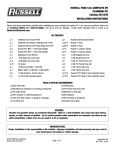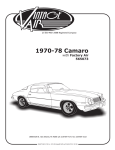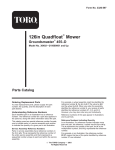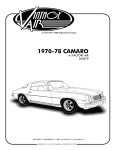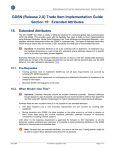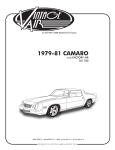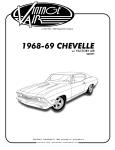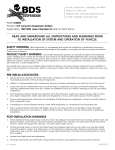Download Edelbrock 641530 Automobile Parts User Manual
Transcript
RUSSELL GM LS1 COMPLETE FUEL SYSTEM Catalog #641530 INSTALLATION INSTRUCTIONS Please study these instructions carefully before installing your new complete fuel system kit. If you have any questions, please call our Technical Hotline at: 1-800-416-8628, 7:00 am to 5:00 pm, Monday - Friday, Pacific Standard Time or e-mail us at [email protected]. KIT CONTENTS ❑1 ❑1 ❑1 ❑1 ❑2 ❑2 ❑2 ❑3 ❑ 12 ❑1 ❑1 ❑5 ❑ 20 ft. Edelbrock Fuel Pump #1790 Edelbrock Fuel Pressure Regulator Kit #1728 Edelbrock Victor Jr. LS1 Fuel Rail Kit #3638 Edelbrock Electric Fuel Pump Relay Kit #1795 Russell 3/8” NPT x -6 AN male adapter Russell 3/8” NPT x -8 AN male adapter -8 AN dry sump union -6 AN dry sump union Tie wraps 10 Micron fuel filter, -10 AN I/O Billet Y-block -10 AN inlet, -8 AN outlets -10 AN straight x -8 flare reducer Russell -8 hose ❑ 20 ft. ❑ 10 ❑ 10 ❑3 ❑4 ❑1 ❑2 ❑2 ❑4 ❑ 10 ft. ❑ 10 ft. ❑1 ❑1 Russell -6 hose Russell -6 cushion clamps Russell -8 cushion clamps -6 AN Straight hose end -8 AN Straight hose end -6 AN 45° Swivel hose end -8 AN 45° Swivel hose end -6 90° Swivel hose end -8 90° Swivel hose end Russell 3/16” Wrap-It wire protective sleeve Russell 5/16” Wrap-It wire protective sleeve Russell assembly lube/sealant kit Russell 0-100 psi fuel pressure gauge TOOLS & SUPPLIES RECOMMENDED ❑ Basic hand tools ❑ AN Wrenches ❑ Miscellaneous hardware for mounting components ❑ EFI fuel line disconnect tool ❑ Drill motor & bits ❑ Multimeter or test light ❑ Wire crimpers or soldering equipment ❑ Wire strippers ❑ Extra wire (Red & Black, 12 gauge & 18 gauge) ❑ Wire terminals & connectors ❑ 10A inline fuse ❑ Assorted nuts & bolts WARNING! Gasoline and gasoline fumes are extremely flammable. Work in a well-ventilated area away from open flames, sparks, or other sources of ignition. Try to contain gasoline when connections are loosened, and clean up any spills immediately. Failure to do so can result in a fire or explosion. IMPORTANT NOTE: Proper installation is the responsibility of the installer. Improper installation will void warranty and may result in poor performance and engine or vehicle damage. ©2007 Edelbrock Corporation Brochure No. 63-641530 Page 1 of 5 Catalog #641530 Rev. 10/07 - AJ/mc BEFORE BEGINNING Someone who has a basic knowledge of automobile repair and modification and is familiar with and comfortable with working on their vehicle can accomplish the mechanical installation of this kit using common tools and procedures. However, this kit is designed to allow you to custom fit the fuel lines and components to your application, and will require that you cut hoses to fit and drill holes for fuel pressure regulator mounting, junction blocks, etc. If you do not feel comfortable with any of the steps listed below, please consult a qualified professional installer. Make sure to read the instructions provided with the supplied fuel rail and fuel pressure regulator. These will be referenced throughout this instruction sheet. WARNING: MAKE SURE TO DISCONNECT YOUR BATTERY TO AVOID THE POTENTIAL FOR SPARKS IN THE WORK AREA! SOME PROCEDURES IN THIS INSTALLATION WILL REQUIRE THE VEHICLE TO BE RAISED ON JACKSTANDS OR A LIFT. WHEN RAISING A VEHICLE, MAKE SURE THE VEHICLE IS ON LEVEL GROUND AND SUPPORTED SECURELY BY JACKSTANDS. NEVER WORK UNDER A VEHICLE THAT IS SUPPORTED BY A JACK ONLY! AFTER INSTALLATION, BEFORE STARTING THE VEHICLE ALWAYS make sure to check for any leaks BEFORE starting the vehicle. Reconnect the battery and turn the ignition key to the “ON“ position. This will activate the fuel pump and pressurize the fuel system. If any leaks are present, turn the ignition “OFF”, disconnect the battery, and make the necessary corrections before continuing. LS1 COMPLETE FUEL SYSTEM KIT Stock fuel rail disassembly: 1. Make sure the vehicle is on level ground, and the gear selector is in park or 1st gear. Set the parking brake or chock the wheels. 2. Make sure that the vehicle has cooled down. 3. Disconnect the negative terminal on the battery. 4. Thoroughly clean the area surrounding the fuel injectors and the fuel rail. This will prevent debris from entering the fuel system or the intake manifold upon fuel rail/injector removal. 8. Remove the fuel regulator, vacuum hose, fuel rail, and the fuel injectors. 9. Inspect and replace the fuel injector o-rings if necessary. 10. You will also need to remove the remaining fuel hard tube (feed and return) running from the fuel rail to the lower firewall. Fuel tank removal: Note: 5. Relieve residual fuel pressure in the fuel system. Remove the dust cap cover over the Schrader valve located on the fuel tube leading to the rail. Hold a shop towel or rag around the valve while relieving the fuel pressure to prevent any fuel spray. 6. Using the EFI coupling release tool, disconnect the fuel feed and return lines. Use a shop towel or rag to catch any residual fuel remaining in the factory lines. 7. Remove the bolts holding the fuel rail to the intake manifold. ©2007 Edelbrock Corporation Brochure No. 63-641530 Page 2 of 5 Use caution when lowering the fuel tank, as some fuel will be remaining in the fuel tank. These instructions have been written with the intent of the installer using a fuel tank or cell equipped with a sump. 1. Drain the fuel from the fuel tank. 2. Raise vehicle using a vehicle lift or by using a jack and jack stands, if necessary. 3. Remove the fuel tank. Make sure to disconnect all fittings and wires attached to the fuel tank. Catalog #641530 Rev. 10/07 - AJ/mc COMPLETE LS1 FUEL RAIL INSTALLATION Russell fuel rail install: 1. Attach supplied brackets to the intake manifold using the supplied hardware. Note: Install most of the necessary components onto the fuel rail before installing in vehicle for ease of assembly. Be sure to use thread sealing compound on NPT threads to prevent leaks. Please note that the instructions below give an example of how this fuel system can be routed. It is highly recommended that the installer preplan the routing of the fuel system kit to determine which fittings should be used for inlets and outlets on the fuel rails, as well as the other components included in this kit. 2. Install the 3/8 NPT male to -8 AN male fittings into the inlets of the fuel rails. 3. Install the 3/8 NPT male to -6 AN male fittings into the outlets of the fuel rails. 4. Mount the assembled fuel rails onto the brackets installed previously. Careful attention should be paid to prevent any damage to the injector o-rings during installation. Fasten the fuel rails to the brackets using the supplied hardware. Note: Find a safe and clean location in the engine compartment for the placement of the fuel regulator and its mounting bracket (supplied). In most applications, the best placement for the regulator is on the firewall. Make sure that the location will allow access for three hoses, entering from the sides and exiting from the bottom of the regulator. Install the vacuum hose from the regulator to the intake manifold. It might be possible to use your stock vacuum hose for the regulator depending on the placement of the fuel pressure regulator. 5. Roughly install the fuel pressure regulator onto the vehicle to facilitate hose assembly installation. Edelbrock fuel pump install: 1. Install two (2) -10 AN to -8AN fittings into the fuel pump. 2. Find a suitable location for the fuel pump on the vehicle. It is highly recommended that the fuel pump is located below the sump of the fuel tank to prevent any fuel from draining back into the tank. 3. Following the instructions included with the fuel pump, install the fuel pump to the vehicle. Russell Relay kit install: 1. Mount Edelbrock fuel pump relay at a suitable location under the hood (e.g. radiator support, inner fender, firewall) away from extreme heat. 2. Run one large (12 gauge) red relay wire back to red lead wire on the fuel pump. Wire can be routed underneath along with other wires, hardlines, etc., or through the interior of the vehicle. A 10 amp inline fuse (not supplied) is recommended on this relay circuit. Note: Route wires so that any possible cutting, chafing, snagging, pinching, or burning from suspension, driveline, or exhaust components will be avoided. Cover wires with supplied Russell Wrap-IT protective sleeve, and use supplied cable ties to secure wires. 3. Connect other large (12 gauge) red relay wire to the positive (+) battery terminal. Fuel pressure regulator install: 1. 4. Some modification to the fuel pressure regulator bracket may be needed for the correct fitment in your desired location. Refer to the included fuel pressure regulator instructions for details. 2. Following the instructions provided with the fuel pressure regulator, mark and drill the mounting holes for the fuel pressure regulator bracket. 4. Connect small pink relay wire to a 12V switched (“keyon”) power supply (e.g. terminal in a fuse box or splice on ignition switch). 3. Install 3 dry sump fittings (-6 AN) into the inlet and exit ports of the regulator. 5. Connect black relay wire and black fuel pump lead wire to a good chassis, engine, or battery ground. ©2007 Edelbrock Corporation Brochure No. 63-641530 Page 3 of 5 Catalog #641530 Rev. 10/07 - AJ/mc Russell Profilter install: 1. 2. 3. Install two (2) -10 AN to -8 AN fittings into the Profilter. Note the inlet and outlets of the fuel filter during the installation. 3. Determine the hose paths and lengths required for the fuel hose leading from the fuel filter outlet to the inlet of the Y block. Build and install the hose assembly. 4. Determine the hose path and lengths required for the fuel hose leading from the outlets of the Y-block to the inlets of each of the fuel rails. Build and install the two hose assemblies. 5. Determine the hose path and lengths required for the fuel hoses leading from outlets of the fuel rails to the inlets of the fuel pressure regulator. Build and install the two hose assemblies. 6. Determine the hose path and lengths required for the fuel hose leading from the fuel pressure regulator outlet to the fuel tank inlet fitting (not included). 7. Properly install the fuel pressure regulator to the chassis at this time. Find a suitable location for the Profilter on the vehicle. The location should allow for easy access to the fuel filter to facilitate servicing in the future. Install the fuel filter onto the vehicle using the supplied bracket. Russell Y-Block install: 1. Install the -10 AN to -8AN adapter fitting into the bottom of the Y-block. 2. Install the -8 AN dry sump adapter fittings into the two exit ports of the Y-block. 3. Install the fuel pressure gauge into the 1/8 NPT port located on the front of the Y-block. 4. Find a suitable location for the Y-block on the vehicle. It might be necessary to fabricate a custom mounting bracket to install the Y-block. Final assembly checklist: 1. Make sure all connections are tight. Make sure the fuel supply and return hoses were not kinked or pinched during installation. Check for any interferences around the fuel system hoses and fittings. The use of tie wraps to secure the hoses is recommended. 2. Reconnect the negative battery terminal. Turn the ignition or fuel pump power switch to the “on” position, but do not start vehicle. Check for leaks. 3. With the ignition still in the “on” position, adjust the fuel pressure to the desired level. Refer to the instructions provided with the fuel pressure regulator for proper adjustment procedures. Continue to check for leaks. 4. Refer to the instructions provided with the fuel pressure regulator for additional adjustments after starting the vehicle. Russell fuel hose assembly and install: Note: Follow the included hose assembly instructions to properly build the hose assemblies for the fuel system. Ensure that the fuel hoses are properly located and installed so as to prevent damage during the normal operation of the vehicle. Please note that the instructions below give an example of how this fuel system can be routed. It is highly recommended that the installer pre-plan the routing of the fuel system kit to determine which hose end fittings should be used for each hose assembly. Use the supplied hose cushion clamps to support the fuel hose as needed. 1. Determine the hose path and length required for the fuel hose leading from the fuel tank outlet fitting (not included) to the fuel inlet fitting of the fuel pump. Build and install the hose assembly. 2. Determine the hose path and length required for the fuel hose from the fuel pump to the fuel filter inlet. Build and install the hose assembly. ©2007 Edelbrock Corporation Brochure No. 63-641530 Page 4 of 5 Catalog #641530 Rev. 10/07 - AJ/mc ©2007 Edelbrock Corporation Brochure No. 63-641530 Page 5 of 5 Catalog #641530 Rev. 10/07 - AJ/mc Edelbrock Corporation, 2700 California St., Torrance, CA 90503 Tech Line: 800-416-8628 E-Mail: [email protected] ©2007 Edelbrock Corporation Brochure No. 63-641530 Catalog #641530 Rev. 10/07 - AJ/mc






